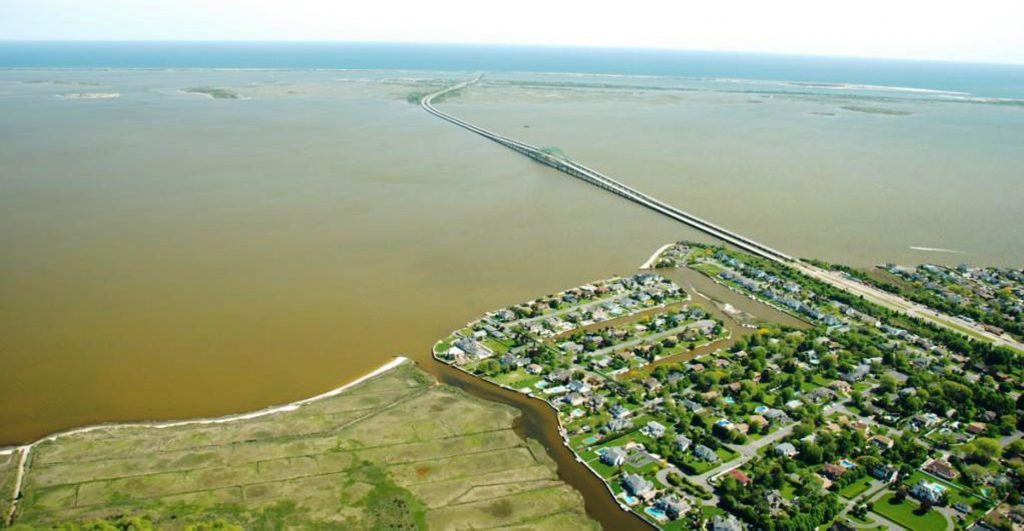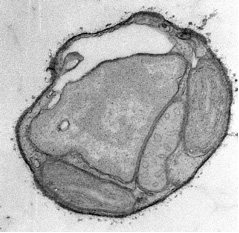Global S&T Development Trend Analysis Platform of Resources and Environment
| NCCOS Research Explores New Approaches to Decoding Brown Tide in Long Island Estuaries | |
| admin | |
| 2020-07-14 | |
| 发布年 | 2020 |
| 语种 | 英语 |
| 国家 | 美国 |
| 领域 | 资源环境 |
| 正文(英文) |  A brown tide bloom in Great South Bay, Long Island, NY .Credit: Dr. Chris Gobler, Stony Brook University. Brown tides, caused by the algal species Aureococcus anophagefferens, have been plaguing Long Island estuaries for 35 years, and can have severe impacts on fisheries, seagrass beds, and aquaculture. To date, multiple hypotheses have been put forth to explain the occurrence of these events. Results from a five-year, NCCOS-sponsored research project on brown tide in Long Island Estuaries were highlighted at a recent New York Sea Grant seminar.  Thin-section transmission electron microscope (TEM) of Aureococcus anophagefferens. Credit: Roger Anderson, Columbia University. The development of more effective management strategies for brown tides requires a deeper understanding of the causes of these blooms. With funding from the NCCOS Ecology and Oceanography of Harmful Algal Blooms (ECOHAB) program, this project examined transcriptomes, or the the entire collection of RNA sequences in a cell produced by the genome of an organism under specific conditions, to determine the causes of brown tides. In 2016, the Gobler Lab sampled a brown tide during the initiation, peak, and collapse phases of the bloom, while concurrently measuring several environmental parameters and new molecular markers of cellular processes. They conducted experiments to explore how changes in environmental factors, like levels of nutrients or exposure to zooplankton grazing, can alter cell numbers and specific molecular markers in both the brown tide organism, and competing phytoplankton. The results were presented by Dr. Christopher Gobler of Stony Brook University on June 25, 2020, during the New York Sea Grant online seminar. Generating transcriptomes for Aureococcus cultures allowed researchers to link expression of genes by the brown tide and competing phytoplankton to specific environmental conditions to define the precise niche of each algal species, providing novel insight into how brown tides are developed and sustained. Major ECOHAB project conclusions regarding Long Island brown tide:
For additional information, contact Quay Dortch. |
| URL | 查看原文 |
| 来源平台 | National Centers for Coastal Ocean Science |
| 文献类型 | 新闻 |
| 条目标识符 | http://119.78.100.173/C666/handle/2XK7JSWQ/283601 |
| 专题 | 资源环境科学 |
| 推荐引用方式 GB/T 7714 | admin. NCCOS Research Explores New Approaches to Decoding Brown Tide in Long Island Estuaries. 2020. |
| 条目包含的文件 | 条目无相关文件。 | |||||
| 个性服务 |
| 推荐该条目 |
| 保存到收藏夹 |
| 查看访问统计 |
| 导出为Endnote文件 |
| 谷歌学术 |
| 谷歌学术中相似的文章 |
| [admin]的文章 |
| 百度学术 |
| 百度学术中相似的文章 |
| [admin]的文章 |
| 必应学术 |
| 必应学术中相似的文章 |
| [admin]的文章 |
| 相关权益政策 |
| 暂无数据 |
| 收藏/分享 |
除非特别说明,本系统中所有内容都受版权保护,并保留所有权利。
修改评论